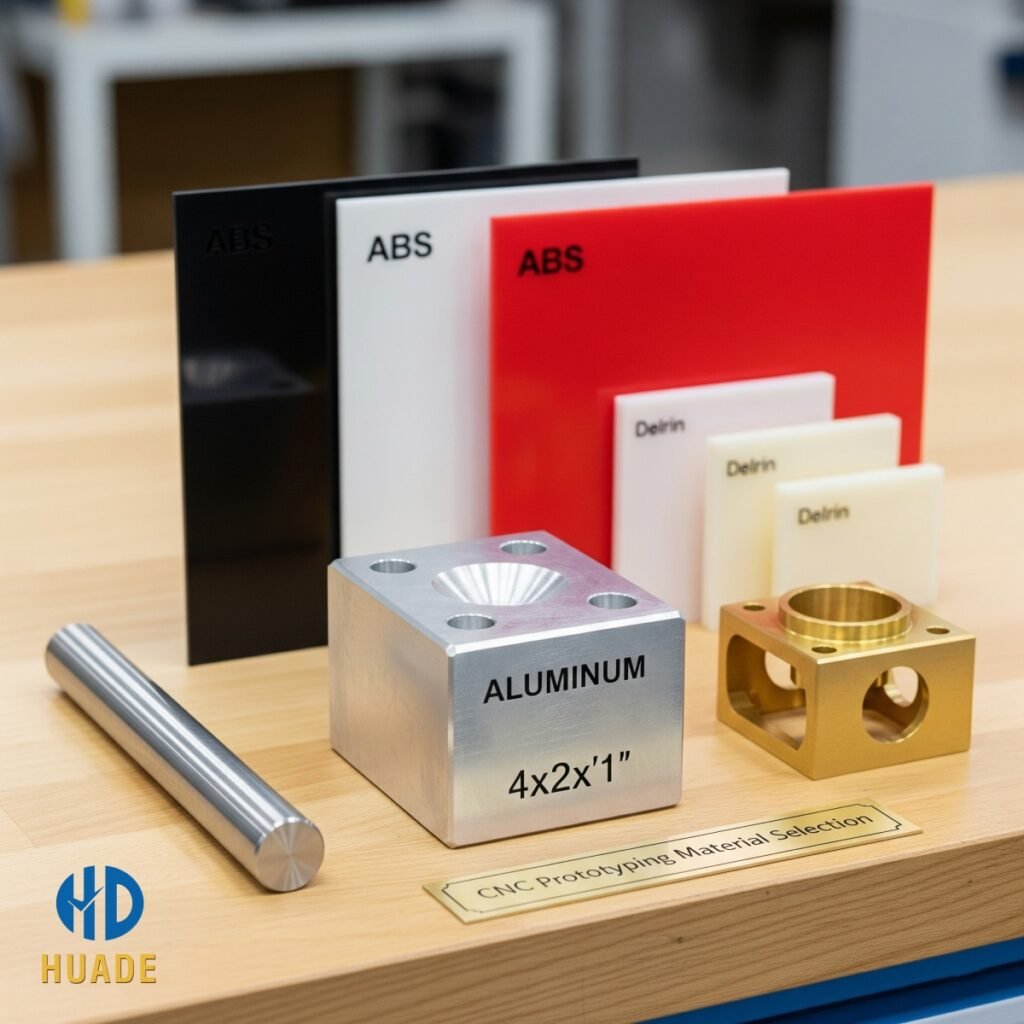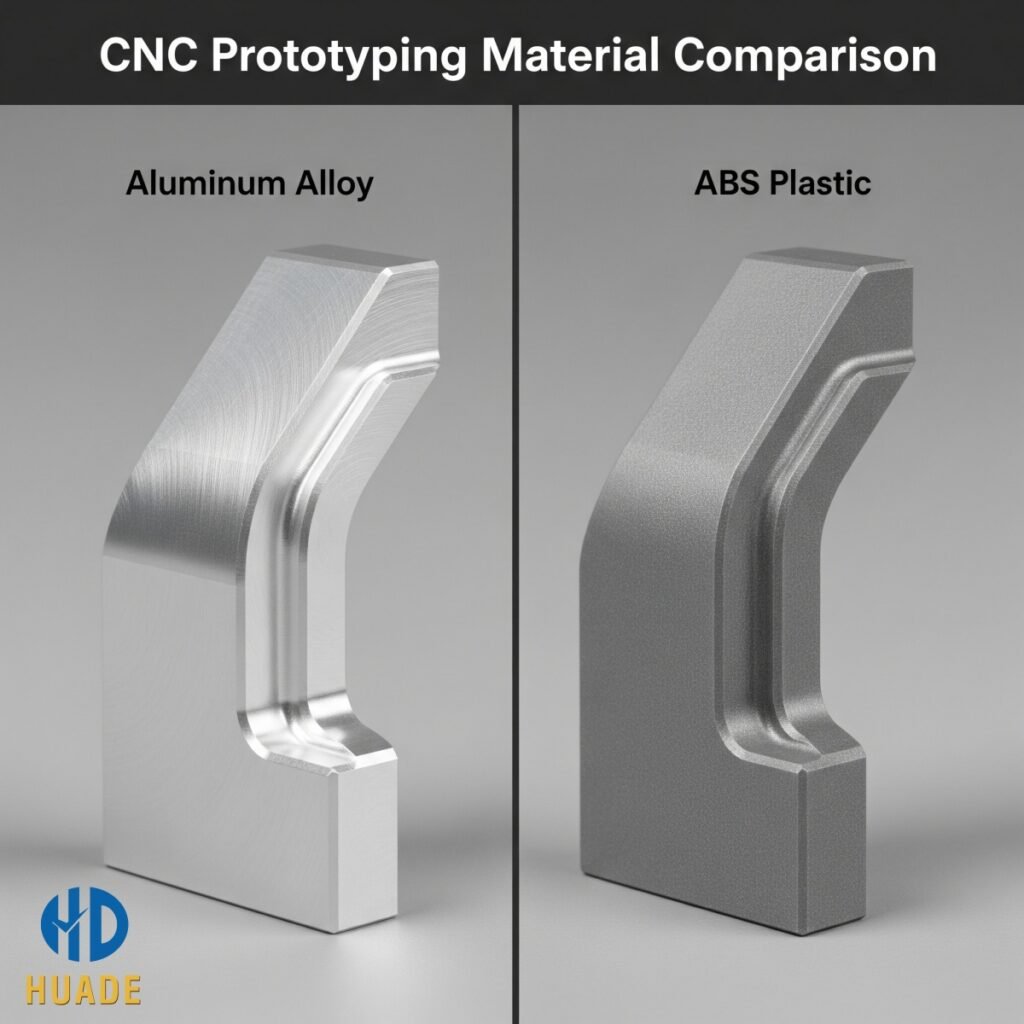
A collection of common CNC prototyping materials on a workbench, including aluminum, stainless steel, and various plastics. This image visually represents the material selection process for CNC parts.
When you embark on a new product development journey, turning your digital design into a physical prototype is a critical step. While CNC machining offers incredible precision, the success of your prototype often hinges on a single, crucial decision: selecting the right CNC prototyping materials. The material you choose will determine your part’s mechanical properties, durability, cost, and even its final appearance.
This guide will walk you through the essential factors to consider and provide a detailed comparison of seven of the most common materials used in CNC prototyping. By the end, you’ll be well-equipped to make an informed choice that aligns with your project’s goals.
The Key Factors to Consider
Before diving into material comparisons, it’s vital to evaluate your prototype’s specific needs. Ask yourself these questions:
- Functionality: What will the prototype be used for? Will it undergo stress testing, thermal cycles, or be a non-functional aesthetic model?
- Environmental Conditions: Will the part be exposed to high temperatures, chemicals, or moisture?
- Mechanical Properties: What level of strength, stiffness, or hardness does your part require? Does it need to be lightweight or have a low friction coefficient?
- Budget & Cost: How does the material cost fit into your project’s budget? Remember that material is just one part of the total
CNC prototyping cost。 - Aesthetics: Does the final prototype need a specific appearance or surface finish?
Detailed Comparison of 7 Common CNC Prototyping Materials
Here is a detailed breakdown of the materials most frequently chosen for CNC prototyping projects, highlighting their pros and cons.
| Material | Key Properties | Typical Applications |
| Aluminum 6061 | Excellent strength-to-weight ratio, great thermal and electrical conductivity, easy to machine. | Aircraft parts, automotive components, electronic enclosures. |
| Stainless Steel 304 | High corrosion resistance, very durable, high strength. | Medical instruments, kitchenware, industrial equipment. |
| Brass C360 | High ductility, great conductivity, very machinable, low friction. | Fittings, connectors, gears, decorative parts. |
| Delrin (POM) | Low friction, high stiffness, excellent dimensional stability. | Gears, bearings, pump parts, automotive interior components. |
| ABS | Impact resistance, good rigidity, cost-effective, easily glued and painted. | Electronic enclosures, consumer goods, protective casings. |
| Polycarbonate (PC) | High impact strength, optically clear, good heat resistance. | Lenses, protective shields, automotive dashboards. |
| Nylon 6/6 | High tensile strength, wear resistance, chemical resistance. | Bearings, gears, structural components requiring durability. |

A comparison image of a CNC machined part made from aluminum alloy on the left and a part made from ABS plastic on the right, highlighting the differences in texture and finish.
Navigating Material Selection: Our Expert Advice
Choosing the right CNC prototyping materials can be daunting, but understanding your end-use case is the most important step. For instance, if you’re building a functional test for a consumer product’s casing, a robust and cost-effective plastic like ABS might be the perfect fit. Conversely, if your project involves high-stress mechanical components for an industrial machine, a strong metal like stainless steel would be the ideal choice.
Keep in mind that the material’s machinability and cost directly influence the final price and lead time of your project. Materials like aluminum are generally easier and faster to machine than stainless steel, which is reflected in the quote.
If you are still unsure about which material is best for your specific application, our team of engineers at Dongguan Huade Precision Manufacturing Co., Ltd. is here to help. With years of experience in CNC prototyping, we can provide professional recommendations and design for manufacturability (DFM) feedback to ensure your project’s success.
To learn more about the complete end-to-end process, from design to delivery, and to see how materials fit into the bigger picture, explore our comprehensive guide on [CNC prototyping].
Ready to Get Started?
Don’t let the material selection process slow down your innovation. Visit our CNC prototyping products to see examples of parts we’ve created from various materials, and when you’re ready, contact our CNC machining experts to get a free quote for your next project. We are your trusted partner in turning your ideas into a tangible reality.
